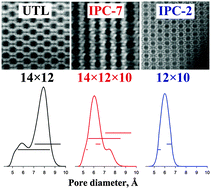The advanced investigation of pore networks in isoreticular zeolites and mesoporous materials related to the IPC family was performed using high-resolution argon adsorption experiments coupled with the development of a state-of-the-art non-local density functional theory approach. The optimization of a kernel for model sorption isotherms for materials possessing the same layer structure, differing only in the interlayer connectivity (e.g. oxygen bridges, single- or double-four-ring building units, mesoscale pillars etc.) revealed remarkable differences in their porous systems. Using high-resolution adsorption data, the bimodal pore size distribution consistent with crystallographic data for IPC-6, IPC-7 and UTL samples is shown for the first time. A dynamic assessment by positron annihilation lifetime spectroscopy (PALS) provided complementary insights, simply distinguishing the enhanced accessibility of the pore network in samples incorporating mesoscale pillars and revealing the presence of a certain fraction of micropores undetected by gas sorption. Nonetheless, subtle differences in the pore size could not be discriminated based on the widely-applied Tao–Eldrup model. The combination of both methods can be useful for the advanced characterization of microporous, mesoporous and hierarchical materials.

